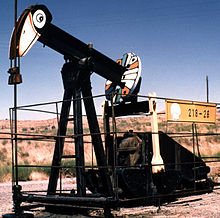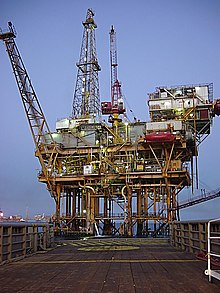store gas engine
#26

[h=2]Chemical analysis and production[edit][/h]
Some of the main components of gasoline: isooctane, butane, 3-ethyltoluene, and the octane enhancer MTBE.

A pumpjack in the United States

An oil rig in the Gulf of Mexico
Gasoline is produced in oil refineries. Roughly 19 US gallons (72 L) of gasoline is derived from a 42-gallon (159 L) barrel of crude oil. Material separated from crude oil via distillation, called virgin or straight-run gasoline, does not meet specifications for modern engines (particularly the octane rating, see below), but can be pooled to the gasoline blend.
The bulk of a typical gasoline consists of hydrocarbons with between 4 and 12 carbon atoms per molecule (commonly referred to as C4-C12).[SUP][5][/SUP] It is a mixture of paraffins (alkanes), cycloalkanes (naphthenes), and olefins (alkenes), where the usage of the terms paraffin and olefin is particular to the oil industry. The actual ratio depends on:
Currently, many countries set limits on gasoline aromatics in general, benzene in particular, and olefin (alkene) content. Such regulations led to increasing preference for high octane pure paraffin (alkane) components, such as alkylate, and is forcing refineries to add processing units to reduce benzene content. In the EU the benzene limit is set at 1% volume for all grade of automotive gasoline.
Gasoline can also contain other organic compounds, such as organic ethers (deliberately added), plus small levels of contaminants, in particular organosulfur compounds, but these are usually removed at the refinery.

Some of the main components of gasoline: isooctane, butane, 3-ethyltoluene, and the octane enhancer MTBE.

A pumpjack in the United States

An oil rig in the Gulf of Mexico
Gasoline is produced in oil refineries. Roughly 19 US gallons (72 L) of gasoline is derived from a 42-gallon (159 L) barrel of crude oil. Material separated from crude oil via distillation, called virgin or straight-run gasoline, does not meet specifications for modern engines (particularly the octane rating, see below), but can be pooled to the gasoline blend.
The bulk of a typical gasoline consists of hydrocarbons with between 4 and 12 carbon atoms per molecule (commonly referred to as C4-C12).[SUP][5][/SUP] It is a mixture of paraffins (alkanes), cycloalkanes (naphthenes), and olefins (alkenes), where the usage of the terms paraffin and olefin is particular to the oil industry. The actual ratio depends on:
- the oil refinery that makes the gasoline, as not all refineries have the same set of processing units;
- the crude oil feed used by the refinery;
- the grade of gasoline, in particular, the octane rating.
- straight-run gasoline, usually also called naphtha is distilled directly from crude oil. Once the leading source of fuel, its low octane rating required lead additives. It is low in aromatics (depending on the grade of crude oil), containing some cycloalkanes (naphthenes) and no olefins (alkenes). Between 0 and 20% of this stream is pooled into the finished gasoline, because the supply of this fraction is insufficient[SUP][clarification needed][/SUP] and its RON is too low.[SUP][citation needed][/SUP] The chemical properties (namely octane and RVP) of the straight-run gasoline can be improved through reforming and isomerisation. However, before feeding those units, the naphtha needs to be split in light and heavy naphtha. Straight-run gasoline can be also used as a feedstock into steam-crackers to produce olefins.
- reformate, produced in a catalytic reformer has a high octane rating with high aromatic content, and relatively low olefins (alkenes). Most of the benzene, toluene, and xylene (the so-called BTX) are more valuable as chemical feedstocks and are thus removed to some extent.
- catalytic cracked gasoline or catalytic cracked naphtha, produced from a catalytic cracker, with a moderate octane rating, high olefins (alkene) content, and moderate aromatics level.
- hydrocrackate (heavy, mid, and light) produced from a hydrocracker, with medium to low octane rating and moderate aromatic levels.
- alkylate is produced in an alkylation unit, using as feedstocks isobutane and alkenes. Alkylate contains no aromatics and alkenes and has high MON.
- isomerate is obtained by isomerizing low octane straight run gasoline to iso-paraffins (non-chain alkanes, like isooctane). Isomerate has medium RON and MON, but nil aromatics and olefins.
- butane is usually blended in the gasoline pool, although the quantity of this stream is limited by the RVP specification.
Currently, many countries set limits on gasoline aromatics in general, benzene in particular, and olefin (alkene) content. Such regulations led to increasing preference for high octane pure paraffin (alkane) components, such as alkylate, and is forcing refineries to add processing units to reduce benzene content. In the EU the benzene limit is set at 1% volume for all grade of automotive gasoline.
Gasoline can also contain other organic compounds, such as organic ethers (deliberately added), plus small levels of contaminants, in particular organosulfur compounds, but these are usually removed at the refinery.
#27
Been running my weed wacker on regular gas and no name oil for over 20 years without going through any special treatment. When I'm done I put it in the shed for the winter and forget it. next spring 3-4 pulls and away we go. I've yet to change the plug and the same for my saw and leaf blower. I'm thinking it would make a good airplane engine 

#29
Senior Member
Al is right on...no point overthinking this. Gasoline has become super simple in the past few years. Simpler than glow by quite a bit.
One of of my friends who currently uses electric exclusively (moved from glow about 7 years ago) and flies top level aerobatics, is a past Nat's Champion. Dave was visiting yesterday and stated he doesn't miss glow at all. I had to agree. Gas is nearly as simple as electric, especially the lack of maintenance part.
One of of my friends who currently uses electric exclusively (moved from glow about 7 years ago) and flies top level aerobatics, is a past Nat's Champion. Dave was visiting yesterday and stated he doesn't miss glow at all. I had to agree. Gas is nearly as simple as electric, especially the lack of maintenance part.
#30

My Feedback: (19)
Capt'n, the Wiki article is all very nice but I fail too see any mention of your beloved Puregas.
Non-ethanol gas is widely available in my state (where we produce a large percentage of the ethanol used in the country) which seems a bit ironic. The Iowa outlets listed on the Puregas site market a blend of premium and standard base stock gasoline, mixed to produce an octane number that matches the ethanol containing fuels. Same base stock fuels used in each case that came to the state in the same pipeline, etc. The same process pretty much repeats itself where ever Puregas is sold though many states market the non-ethanol, higher octane premium fuels as Puregas. Most often marketed as marine, classic car or off road use. There really isn't anything magic about Puregas except the lack of ethanol. And yes, I use to haul the stuff many years ago and still know people in the industry.
I agree with the last few threads, no reason to overthink this stuff.
Non-ethanol gas is widely available in my state (where we produce a large percentage of the ethanol used in the country) which seems a bit ironic. The Iowa outlets listed on the Puregas site market a blend of premium and standard base stock gasoline, mixed to produce an octane number that matches the ethanol containing fuels. Same base stock fuels used in each case that came to the state in the same pipeline, etc. The same process pretty much repeats itself where ever Puregas is sold though many states market the non-ethanol, higher octane premium fuels as Puregas. Most often marketed as marine, classic car or off road use. There really isn't anything magic about Puregas except the lack of ethanol. And yes, I use to haul the stuff many years ago and still know people in the industry.
I agree with the last few threads, no reason to overthink this stuff.
#31

Thread Starter
Join Date: Jun 2003
Location: quincy,
MI
Posts: 1,205
Likes: 0
Received 0 Likes
on
0 Posts
Thanks for all the input, glad I asked.Good to know there is not a lot to do to store gas engines.
I try and take care of my stuff, seemsto pay off in the long run. I use Star Tron mix in all my smallengines, it negates the effect of ethanol in the fuel and cleanscarbs and prolongs the fuel life for two years.
I just started using it in my glowengines last summer and they are running better than ever. If fact Idon't have to adj. The needle valves anymore, have not touched onefor a year now. I think it keeps the needle seats from varnishing up.
I plan to get away from glow down theroad, cost, and it is a mess compared to gas.
sticks
I try and take care of my stuff, seemsto pay off in the long run. I use Star Tron mix in all my smallengines, it negates the effect of ethanol in the fuel and cleanscarbs and prolongs the fuel life for two years.
I just started using it in my glowengines last summer and they are running better than ever. If fact Idon't have to adj. The needle valves anymore, have not touched onefor a year now. I think it keeps the needle seats from varnishing up.
I plan to get away from glow down theroad, cost, and it is a mess compared to gas.
sticks




